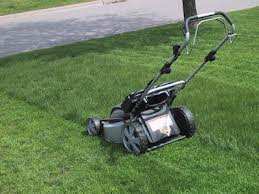 For most of us, the lawn is the biggest part of our yard. You may spend much time and money in keeping it healthy, lush and green to bring a sense of elegance. However, you may don’t know how to do it and waste a lot of resources.
For most of us, the lawn is the biggest part of our yard. You may spend much time and money in keeping it healthy, lush and green to bring a sense of elegance. However, you may don’t know how to do it and waste a lot of resources.
Here are some tips on how to keep your lawn healthy, lush and environmentally?
Mowing
Keep the blades sharpened in the spring and then set them slightly higher.
In order to cut more leaf surface on weeds that may help the grass compete with them and to reduce soil compaction and turf wear from the wheels, try to mow in different directions and alter the pattern each time.
Keep shrub and flower bed level with the lawn, so you can overlap with the mower. Eliminate tight corners and pockets to fit your mower. Maintain a cultivated area between the lawn and these objects.
Watering
The amount of water is different since it depends on soil type, species of grass, mowing height, temperature, wind and other factors. Measure rainfall and sprinkler water with a rain gauge.
Generally, one inch is enough for soaking. High spots and south-facing slopes need more water. The areas that receive less than 4 hours of direct sunlight daily need less water.
Fertilizing and weeding
Typical turf fertilizers in today are slow-release granules that release nutrients over several months.
It is unnecessary to water the turf roots that have slow-release nutrients.
After watering when the soil is moist and soft, you can pull stubborn weeds by hand.
Repairing weak spots
Reseeding is an efficient way to repair larger dead patches. First, mix grass seed into compost or soil in a container. Then, spread the mixture over the dead spot. After it is dry, lightly pack it by stepping on it. Keep watering until the seedlings become established.
Thatch
Thatch is a layer of dead and living shoots, stems and roots that builds up between the green vegetation and the soil surface. If the growth of the crowns and lateral stems exceeds their decomposition, it will accumulate. When it builds up to a thickness of more than 1/2 inch, it restricts water, air and fertilizers move into the soil, leading to the invasion of more insect, disease and weed.
You can easily check whether your lawn needs to be dethatched or not by cutting a plug of grass and soil several inches deep and examining it. If there is a dense layer of spongy vegetation and organic (peat-like) material between the crown of the grass plants and the soil of more than 1/2 inch, then you need to dethatch.
Shade
If the lawn receives much traffic, lawn grasses need to get 6 hours of direct sun daily. If not, it needs 4 hours of direct sun daily at least.
Creeping red fescue tolerates shade better than Kentucky bluegrass. If the grasses shorter than 3 inches in the shady areas, never mow them. Shady areas need less water and fertilizer than the sunny part of your lawn.
Click here to see what others are saying…